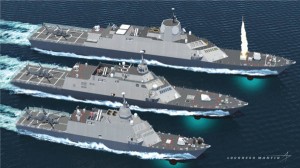 So, last week the Small Surface Combatant Task Force announced a call for ideas on a small future surface combatant, complete with substantial pricing and production information and–if a boat-load of pricing and production data wasn’t enough–operational concepts as to how the ship will fit and fight with the fleet.
So, last week the Small Surface Combatant Task Force announced a call for ideas on a small future surface combatant, complete with substantial pricing and production information and–if a boat-load of pricing and production data wasn’t enough–operational concepts as to how the ship will fit and fight with the fleet.
Goodness. Where does one sign up to offer a response, you ask?
Don’t bother.
I don’t think Industry opinion matters a whole lot. Not to be too cynical, but my overarching sense is that this Small Surface Combatant RFI has been written by a team that already knows the answer they seek, and the RFI is merely an expensive exercise in “discovering” defense industry affirmation.
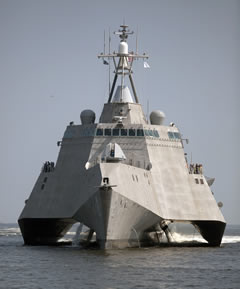 First Take: Advantage Lockheed
First Take: Advantage Lockheed
After a first read, this RFI seems to favor ship-and-systems-of-systems guys with fairly-complete, well-integrated product lines–i.e., Lockheed. Lockheed is, I think, best-positioned to provide a response that will resonate with the RFI’s detail-oriented focus. Lockheed’s market strategy of trying to “own and integrate” everything on Surface Ships–from combat systems to sensors to effectors–is really paying off here.
Lockheed aside, this is an RFI only a big defense contractor can love. The level of detail requested, when combined with the modest 3-week time-period given to respond, is daunting enough for the big guys who already have this stuff largely in the can.
It is, in my view, somewhat ironic that a program originally intended to empower small shipyards has spawned an RFI of such complexity that only the big shipyards/big defense contractors will have a hope of providing the detail required to generate the accurate, hi-fidelity response the Navy is looking for.
Why demand such detailed pricing and production estimates? From an RFI? That’s just asking for smaller shipyards to get into trouble. If I’m a small-margin shipbuilder, I’d be terrified to reveal too much at this stage. At a minimum, the low-overhead pricing advantage of minor shipyards will vanish as their lack of intimate knowledge of the warfighter tradespace leads to both higher quotes from suppliers and a larger self-imposed risk premium. The larger guys–with high-overhead warfighter and systems guys down the hall and on staff–will be able to offer a far more detailed–and likely initially lower–price than the smaller competitors.
And that’s not all–the Navy’s “Small Ship” team wants industry-developed CONOPs. Now, I think that is a great step, as I am eager to see defense contractors get more engaged in “activating” the public sphere to spark wider public debate on naval power. Encouraging defense contractors to start discussing their vision of the future battlefield–in a more public forum–is a good thing. And yes, an RFI isn’t public, but it sure helps defense contractors figure out what they want to talk about.
But, all in all, this CONOPs request is a pretty significant competitive burden for small shipyards. Small shipbuilders like Eastern or VT Halter or Bollinger are experts at building ships, and not necessarily skilled in justifying their product’s existence on the battlefield (and, frankly, generations of Navy Program Managers have demanded producers stick to production and leave platform justification to the Navy). Perhaps in some well-developed cases–the three Offshore Patrol Cutter finalists and VT Halter’s interesting Egyptian Patrol Ships,–this request is not such a big risk. But the diversified big defense/big shipbuilding contractors are far more prepared to take on the task of justifying their products than the little guys.
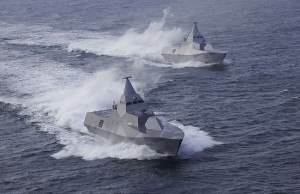 What Does the Task Force Want?
What Does the Task Force Want?
Well, the Small Surface Combatant Task Force wants a “small surface combatant”.
But what does that mean? Really?
Well, notice the RFI writers don’t define what, exactly, a small surface combatant is. They try to define “small” by missions–I.E. a “uniquely suitable asset for Theater Security Cooperation tasking and select sea control missions.” Ok. So we’re talking anything from a stripped-down DDG-51 to an “up-gunned” LCS to an Offshore Patrol Cutter or…something smaller.
It’s really a rather odd little fishing expedition–There’s virtually no guidance as to what the Navy wants beyond a brief reference back to the Defense Strategic Guidance (and, oddly enough, no references to Secretary of Defense Chuck Hagel’s memo that sparked this exercise, either).
I am also perplexed as to why the RFI writers use the Defense Strategic Guidance (of 2012) as a doctrinal starting point for discussion of an evolved LCS. Aside from the fact that the Defense Strategic Guidance is, well, somewhat dated–coming from the “Grand Old Days of COIN”, it’s not the right doctrinal tool to use to justify the next Small Surface Combatant.
In my view, this ship is the future of the Navy–the training ground for the next generation of Navy leaders, and a big part of the operational fleet. So…Look to the Navy for guiding doctrine. Given that this committee is Chief of Naval Operations Admiral Greenert’s creation, why not start with his excellent Sailing Directions, and work back from there?
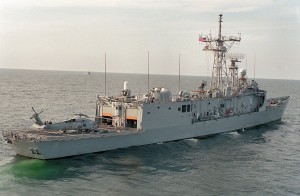 DoD and Navy: Different Visions
DoD and Navy: Different Visions
As I have written before, there is a lot of distance between CNO Admiral Greenert’s Sailing Directions and the Defense Strategic Guidance. The Navies each doctrine envisions are very, very different.
The Defense Strategic Guidance focuses on power projection, while Greenert’s Sailing directions focus more on Sea Control.
But, for whatever reason, the Small Surface Combatant Team used the Defense Strategic Guidance as their guide, so the doctrinal foundations of the RFI need to be explored in a bit more detail.
According to the RFI:
“Small surface combatants enable the Navy to implement the Defense Strategic Guidance (DSG) imperative to develop innovative, low-cost, and small-footprint approaches to achieve our security objectives”
Well, first off, that’s not an entirely accurate assertion. The most successful–and most recent–“innovative, low-cost and small-footprint” approaches to “achieve our security objectives” has been (arguably) the deployment of missile-defense DDG-51s to Rota. Or the Ponce’s successful deployment to the Gulf–no “small combatant” these, right?
Anyway, if the Small Surface Combatant Task Force is using the Defense Strategic Guidance as their doctrinal foundation, it is worth going to the Defense Strategic Guidance to mull what this “imperative” actually is.
The context is revealing:
“Building partnership capacity elsewhere in the world also remains important for sharing the costs and responsibilities of global leadership. Across the globe we will seek to be the security partner of choice, pursuing new partnerships with a growing number of nations – including those in Africa and Latin America – whose interests and viewpoints are merging into a common vision of freedom, stability, and prosperity. Whenever possible, we will develop innovative, low-cost, and small-footprint approaches to achieve our security objectives, relying on exercises, rotational presence, and advisory capabilities.”
From this, it sure looks like we’re seeking a partnership platform, size and Sea Control be damned.
But before rushing out to propose a partnership platform (Hey, why not JHSV?), go and look at the security objectives spelled out the the National Strategy (which was built on work from 2010–a very different time) Here are the mission sets that DOD grew out of the National Strategy:
- Counter Terrorism and Irregular Warfare
- Deter and Defeat Aggression.
- Project Power Despite Anti-Access/Area-Denial Challenges
- Counter Weapons of Mass Destruction
- Operate Efficiently in Cyberspace and Space
- Maintain a Safe, Secure and Effective Nuclear Deterrent
- Defend the Homeland and Provide Support to Civil Authorities
- Provide a Stabilizing Presence
- Conduct Stability and Counterinsurgency Operations
- Conduct Humanitarian, Disaster Relief and Other Operations.
The bold print is particularly important–While all the missions are vital, the Strategic Guidance notes that only the bolded missions will drive requirements for the future force.
But I sure don’t see those missions being discussed in this RFI.
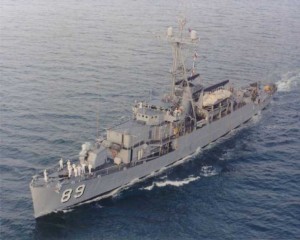 Missions That Drive Requirements:
Missions That Drive Requirements:
Putting the nuclear deterrent mission aside as it is not applicable to this platform, the remaining three missions that should drive DOD acquisition priorities (1.Counterterrorism and irregular warfare; 2. counter and defeat aggression, and 3. defend the Homeland and provide support to Civil Authorities) suggest that some kind of a militarized marriage of Coast-Guard Cutter/OPC-like platforms and the old-school utilitarian APD (the World War II-era High Speed Transports) might be the most appropriate choice–A modest presence/patrol/power projection platform.
For those who don’t know, the APD was a high-speed destroyer/amphib hybrid that grew out of an operational World War II requirement for a flexible escort platform capable of projecting power ashore in areas where air support/surface escorts were not guaranteed. (Take a look at the missions and activities of USS Ruchamkin APD-89 over the course of her long life–a useful, do-anything platform, eh?)
Now, I have long thought the APD was the appropriate initial template for the Flight I LCS, and a good jumping-point to a more sophisticated, more “high-end” warfare variant (i.e. following the design spiral from, say the Dutch Absalon Class “support” ships to the later, high-end Iver Huitfeldt Class). Sadly, we tried to reverse this design spiral, allowing efforts to develop innovative Irregular Warfare capabilities for the LCS to be sidelined in favor of the beastly and overpriced Anti-Surface, Anti-Sub and Anti-Mine Mission Module concepts.
But with this RFI, the materiel/gear focus for the Small Surface Combatant RFI is decidedly upon sea-control oriented kit “in the areas of surface warfare, undersea warfare, air warfare, mine warfare, lethality, survivability, endurance, range and speed.”
There is no mention in this RFI of a potential requirement to support projection of force ashore–even though the ability to influence events ashore is particularly relevant for at least two of the three DOD missions that are meant to drive requirements for the future force–i.e. “counterterrorism and irregular warfare” and “defend the homeland and provide support to civil authorities”.
Any interest in amphibious “power projection” is…apparently…gone. And peeling off the amphibious mission is something that should be seen as a major disadvantage for the Independence-variant LCS, which, with a large flight-deck and mission bay, has claimed small-scale amphibious operations (the old APD mission profile) as a natural fit.
If I am right, and the Small Surface Combatant Team is more interested in dialing back the flexible “power projection” capabilities of the LCS in favor of more specialization for “Sea Control”, then I’m perplexed as to why they refer back to the Defense Strategic Guidance that, in the end, favors “power projection”.
This team should have started with CNO Admiral Greenert’s Sailing Directions and ended with ’em.
Now, as I discussed above, when the Small Surface Combatant RFI went live last week, it started with this paragraph:
Small surface combatants enable the Navy to implement the Defense Strategic Guidance (DSG) imperative to develop innovative, low-cost, and small footprint approaches to achieve our security objectives. This type of ship provides Combatant and Fleet Commanders a uniquely suitable asset for Theater Security Cooperation tasking and select sea control missions. These small surface combatants build and strengthen maritime relationships by operating with partners and allies in various theaters of operation
Something changed to de-emphasize–in particular–ship size. Back in April, when the “Intent to Issue a Small Surface Combatant RFI” was published, it included this introductory paragraph:
Small surface combatants enable the Navy to implement the Defense Strategic Guidance (DSG) imperative to develop innovative, low-cost, and small-footprint approaches to achieve our security objectives. This type of ship provides Combatant and Fleet Commanders a uniquely suitable asset for Theater Security Cooperation tasking and select combat operations, freeing large surface combatants to perform other missions. These small surface combatants build and strengthen maritime partnerships by being able to train and operate with smaller, regional navies and to enter previously inaccessible, shallow-water foreign ports.
I have bolded the parts that were changed. Some were interestingly semantic–“Combat operations” become “sea control missions”, maritime “partnerships” became “relationships”–but the effort to distinguish this new combatant from ships of DDG-51-like dimensions…disappeared.
Why? Did the authors suddenly realize that, for example, that size was no longer a distinguishing feature of the LCS? That the fully up-gunned Lockheed-variant LCS was only 14 feet shorter than an old-school DDG-51? I don’t know. But, over the course of a month, there seems to be an effort afoot to de-emphasize size and the “littoral” aspect of these new “low-end” combatants. The change may give us a good idea of how the Small Surface Combatant Task Force is evolving their approach to this challenging aquisition.
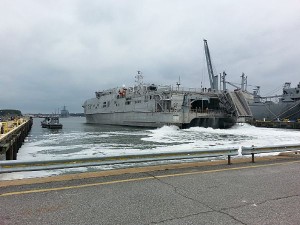 Production, Competition and More…
Production, Competition and More…
Finally, I am fascinated by the RFI’s interest in “Design-to-Print” strategies. That interest may suggest there might be some desire to produce this small platform in a number of different yards.
If so, that effectively sidelines innovative hull materials–at a minimum, no fancy composites–“Design-to-Print” favors the most common material (steel) and an easily-handled range of ship sizes (the smaller the ship, the more yards can handle making it).
But a focus on “design-to-print” sets up a fascinating challenge between folks who already have invested in a rapid, serial production facility (with the attendant specialized workforce) and the interest in spreading nation-wide distribution of a many-ship production run between several different shipyards. The Navy will probably do some thinking about the value of “spreading around” a production run between several yards (and interested political stakeholders) or focusing production at a single, super-efficient facility.
We’ll see how that debate plays out. It’ll be interesting.
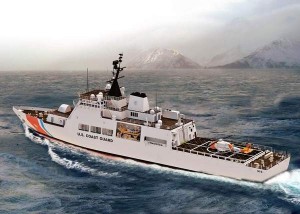 Prepare for Pontius Pilate(X):
Prepare for Pontius Pilate(X):
I strongly suspect CNO Admiral Greenert knows exactly where he wants to go with the next-generation low-end sea control vessel, but I also strongly suspect that he’s politically savvy enough to allow others the likely career-attenuating privilege of forcing his reluctant acquiescence to their strongly-held professional analysis.
This RFI is part of that process.
I may be a bit of an optimist, but I truely wish the Navy had sufficient confidence in itself to make a decision on the future direction of the fleet on it’s own.
But that requires a “damn the torpedoes” type of leadership that may not be effective in modern-day Washington. And when CNO Admiral Greenert surveys his Washington DC “battlespace”, it’s daunting–LCS Champion Robert Work is now the #2 Guy at the Pentagon, and CNO Greenert may be nicely placed to continue on as the Chairman of the Joint Chiefs in two years, so he won’t be eager to alienate Congress by being too “on point” on this.
That said, this RFI is a fishing expedition. Now, to the extent that this RFI will serve in building community consensus on the way ahead, I approve. But I still think the Navy is looking for somebody to propose the solution they want, and that, as a rule, strikes me as a little unfair–particularly to those solid, low-margin yards who struggle to stay lean and can ill afford the investment needed to chase this sort of business.
So….Who will win? I have no idea. I humbly suggest that Lockheed is very well placed–even if a Freedom Variant hullform isn’t a viable contender going forward, Lockheed will get a large piece of business from whatever offering is still standing (if Lockheed doesn’t get a ship, they’ll get business supplying mission components, sensors, the combat systems…something). If the RFI skews towards DoD doctrine, I suspect either a JHSV or Indy-variant will be a favored platform. If not, and the “Future Austere Sea Control Platform”, uh, Small Surface Combatant Task Force skews towards CNO Greenert’s Sailing Directions, I suspect a low-end, austere DDG-51 variant or an OPC to play.
We shall see. It’ll be an interesting ride.
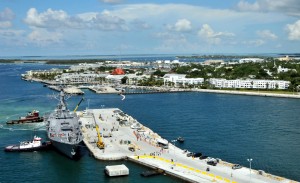

{ 7 comments… read them below or add one }
Overall the bottom line is:
* The LCS, even modified is not designed for long term Blue Water escort, ASW, or contingency operations that will last for some weeks in any theater. They simply are designed for the littorals not deep water. This also makes them less capable in the Arctic.
* Cost wise the LCS is not yet under control and the new modifications will place a further smoke screen over the cost containment and escalation due to modifications, on top of survivability m…ods, with less long term Blue Water capability that is desired. The missions the LCS is designed to do, and the increase in combat capability, does not increase the capability of the seaframe for deep Blue Water operations.
* The best numbers argument is that the NSCs were not bought as a block so the individual price of each unit was rather high. The unit cost for ten units will be much more reasonable, and these units ARE designed for long term Blue Water operations for extended periods of time. Less redesign is needed to incorporate the upgrade combat system elements into the existing hull, and some proposed variants already provide ready designs containing most of the desired elements. The non-rotating 3D radar is the fly in the ointment.
* The NSC is ready for the arctic for which this hull has been specifically designed, and is a 50 year hull.
We would be nuts not to buy NSCs modified to an ASW National Patrol Frigates with AAW capabilities, with a real gun.
Some of arguments made against my comments has been to just want a hi-end surface Small Surface Combatant (SSC) just like an Arleigh Burke. My retort is that the FFG-7s
being withdrawn from service were a multi-warfare ship before they neutered them by removing the Mk13 missile launchers. The FFG-7 was a multi-warfare Blue Water capable platform, which was not optimal but could accomplish the mission. There are many a Fig-sailor who will tell you about bobbing around in the ocean in heavy weather wishing they were wider and a little heavier. The LCS is lighter and even shallower draft
making them less Blue Water capable. What does the “L” is LCS stand for?
The National Security Cutter (NSC) has already demonstrated not only a Blue Water capability, but are more survivable without modification. Making the LCS more
survivable will require some fundamental modifications to this seaframe before
additions to the combat capabilities are incorporated. These modifications will make the LCS hull no more Blue Water capable.
The SSC should be a multi-warfare platform with less than half the Mk41 VLS capacity, but be able to handle all warfare areas. In my opinion that should include a 5” gun
just like our frigates of old, so we can support the Marines in the Pacific Pivot, but it will probably get a 76mm.
Hi-end ? . . . YES. A little Arleigh Burke ? . . . NO!
Blue Water capable and the most value for our dollar ? . . . ABSOLUTELY!!!
You mixed up Dutch and Danish for the Absalons…
The problem with the Burke still comes down to the fact that it’s a $700m hull without any GFE, it’s hard to see even an austere Burke coming in at less than $1bn and it’s not clear where the budget would come for that. Crewing also matters – if you say that each member of crew costs $5m over the lifetime of a ship, a full-fat Burke crew costs $1600m versus $710m for a the crew of a Zumwalt or modern Euro-frigate. Even without Aegis (which the new ship won’t have) and other high-end systems, I suspect that an austere Burke would still need another $200m+ of extra crew versus a more modern design.
I guess the Flight III propulsion is less of an issue just because there are few modern alternatives if you’re looking to power a cruiser-sized ship. Go smaller, and there are options. I think the significance of the “Design-to-Print” emphasis is that it opens you up to licence-building a “foreign” design – although it’s debatable how “foreign” a company like BAE is these days, and their GCS certainly ticks a lot of boxes here. One aspect that’s not talked about much is the extent to which this new ship will be part of the ASW team. Noise from hull and propulsion is not something that gets the attention of the blogosphere like whizz-bang missile systems, but I’m sure that the people who matter will be thinking about it. Again, that might steer you away from LCS variants and towards a proper frigate hull.
Personally I’d like to see how a small LPD would measure up to the requirement – terribly in some ways, but in a lot of respects something like a Galicia derivative would work quite well, and could be based in Rota with easy access to an existing logistics chain.
Rey–
I am beginning to agree with you. That said, there’s not a ton of emphasis on cost savings or commonality with the existing fleet in this RFI.
As this idea has percolated around, though, I am hearing a wave of reactionary muttering about the aged hull and propulsion/power generation systems–which is particularly interesting given the context of the debate over the Flight III DDG-51. If the hull/power arrangement is good enough for the high-end Flight III, why is it now inappropriate for an austere Sea-Control variant?
It’s amusing and has the feel that somebody with a vested interest somewhere is busy trying to throw everything but the kitchen sink at the idea.
My instinct for the DDG-51 (Austere) would be to make it as capable as possible of taking some mix of future weapons/sensors via a quick upgrade. That’d mean making the propulsion/power generation/power movement/storage systems as modern as possible while maintaing as much margin (and as much commonality with the existing fleet) as one could….To me, it’d almost be like we were sailing around in something of an “in ordinary” status, keeping the basic systems running while being full of margin/space for higher-end capability should global conditions demand it. It’s a risk, but…hey, so is retiring half the cruiser fleet.
Great comments Chris and ChrisA.
I’ll riff off of Chris’ last paragraph about how the RFI is broad enough to go in any direction–which means–from my cynical viewpoint–the evaluators will get to present to leadership “obvious choice A” in a background of to totally unviable options (B, C and D).
We’ll see.
I think, regarding potential to set up competition within the industrial base, the Burke/Virginia Class Sub model of competition doesn’t work as well for smaller craft (by really smaller, I mean smaller in size/complexity). Competition for smaller craft is, by the nature of the beast, a far harder-fought thing, and the price that evolves is already so close-to the-bone that the financial health of the winners is at risk (exhibit A: stock prices or fiscal health of the current LCS manufacturers). Competition is alive and well in the smaller-tier shipyards, and a scheme to set up a genteel means to maintain a duopoly is not needed.
Now, if the intent is to build a bunch of these very quickly, then that’s a…whole other ball of wax. I didn’t think the FFG-7 experience went very well, but, that’s just me.
I think competing the combat systems is a good thing. I love the idea of open architecture, but…they all seem as proprietary as Aegis System originally was–built in part to help promote the maker’s already-well integrated systems-of-systems. If open architecture is truly open, how does one compete it? What, pray tell, are the differentiators? Network security? Power demand? Robustness? I throw up my hands at that one…
And finally, going back to the RFI, twenty-five pages is insufficient to capture the data they require. Heck, the “official” LCS CONOPs alone is a gazillion pages…condensing something like that down into a few paragraphs–that, you know, actually mean anything–will be…interesting.
“A low-end, austere DDG-51 variant” is still a powerful warship compared to the flypaper that is an LCS. And that would include an upgrade LCS. I am not going to get into the weeds here. This is to say that I do not have the technical background/expertise to comment on all of what was written in Chris’ post from earlier today, May 7th. Lets face it. Even though I have subscribed to the US Navy Proceedings since 1979, I am really just a Navy history buff who likes to comment on Navy issues.
This being said, I believe that in the end the Navy who I still think sees itself as a true blue-water institution will rule in favor of a DDG-51 variant. As far as being able to be all things to all communities within the Navy, the ship could possess a mine-warfare fighting ability which would be much better suited for a low end Burke than the Aegis equipped Burkes have been asked to perform, ASW abilities, land and ship attack abilities and a limited anti-air component, probably equipped with the latest version of the ESSM.
I could even see the ship being equipped with the new AGS from the Zumwalt class. The new warship would have to have at least at minimum a 5″ 62 caliber weapon, which the current DDG-51’s have. Along with other close in weapons like the CIWS Block 1B, or RAM, and the other close in weapon, the Mk38, Mod 2 25mm chain gun.
As far as manpower is concerned, is this really an issue going forward? Especially when you consider the possibility that the eleven Tico’s being considered for reduced commission status, will undoubtedly have reduced crews as well. And who knows what is going to happen especially with the budget sequester for 2016. Could not all eleven Tico’s be retired permanently?
If the Navy decided to go with a “somewhat reduced capability” Burke, would that not include the Aegis system. Which if I remember is probably the single most expensive item on board. You eliminate the Aegis, and you have a warship that still packs quite a punch for considerably less dollars.
And in the end I believe that is what the Navy will choose to do. Of course this is just my humble opinion.
Craig,
I have to agree that the volume of data being asked for is quite a bit for a non-defense industry contractor. The Government contracting learning curve is a big deterrent to non-defense industry contractors entering the market. As much information is being requested, the twenty-five page limit works against a detailed discussion, particularly of something as broad as a CONOPS.
Build-to-print, the emphasis on mature designs, industrial base, and maintaining a competitive environment seem to hint at a desire to establish something like the DDG-51 competitions between Bath and Ingalls. As you remarked, this probably favors conventional hull forms, which is unfortunate.
It seems to me that if the Navy really wants competition in the industrial base it needs to re-examine its shipbuilding methodology to bring in more than just Lockheed and HII. The Navy used to have the expertise to at least design the hulls, but I do not think that is possible anymore. However, if the Navy were to order a build-to-print hull that is then delivered to a Lockheed for combat systems installation via a set of standard interfaces then you may be able to get other builders to at least build the hull. Of course that would require a defined set of interfaces and would place more of the integration management burden on the Navy, but it would allow more yards to compete. And if the interfaces were standard you might even be able to compete the combat systems.
The muddled doctrinal references are emblematic of over-centralization in the DoD in my opinion. The services chase the OSD flavor of the month like cats chasing a laser pointer. When transformation was fashionable with OSD, everything had to be revolutionary. War on Terror everything is geared/re-packaged as a counter-terrorism tool. The Pacific Pivot is the current flavor, so the Army is running around with strategic land power. Everything is routed/reviewed/approved/pontificated upon by some OSD staffer or five before a program can move out.
Returning to the RFI, the resulting request for proposal (RFP) will be where the rubber meets the road. The Navy has written the RFI sufficiently broad and without detail on what it really wants to enable the RFP to go in any direction. The RFP’s evaluation criteria will show what the Navy is really after or what OSD has told it to buy. A stripped Burke may actually be a strong contender with well-defined information on construction costs, low NRE, and a model for maintaining competition.
It appears small surface combatants don’t inspire as much passion as amphibious connectors. This is a shame to some degree, as the numbers and relative capabilities of the surface combatants have a direct bearing on the required level of war fighting capability in the connectors.
Also, more ships means more opportunities to develop those foundation mariner skills that you just can’t build in a simulator. And, cheaper platforms with lower capabilities means earlier opportunities for command responsibilities.
Whether they are LCS, frigates, or some other yet to be defined label, these ships offer opportunities as well opportunity costs. I for one am interested in seeing how this RFI turns out.